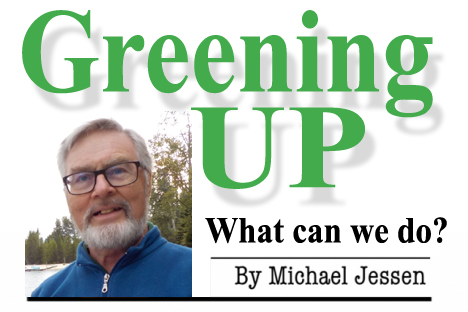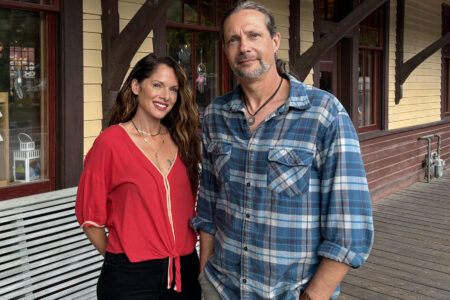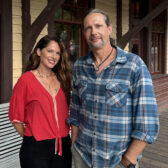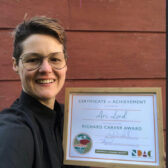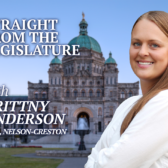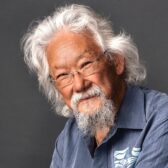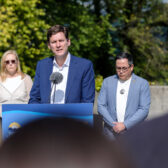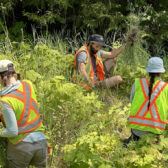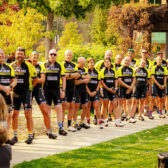Greening Up — If All Else Fails
“It is into the yawning gap between the urgent response scientists say is needed and the timid measures governments are willing to take that geoengineering has stepped.” – Clive Hamilton
Talk about a diverse range of opinions.
Geneticist and broadcaster David Suzuki labels it “insane”, geophysicist Raymond Pierrehumbert calls it “barking mad”, author Naomi Klein describes it as an “escape story”, yet climate scientist Peter Frumhoff says “it is the worst possible way to address climate change that we need to take seriously”, technophile environmentalist David Keith argues it is a “brutally ugly technical fix” that we need to deploy real soon, and science writer Eli Kintisch asserts it is “a bad idea whose time has come”.
“It” is solar radiation management (SRM), a form of geoengineering that has theoretically the potential to offset some human-induced global warming by reflecting solarenergy back into space.
But there was no difference of opinion in a United Nations report released August 9th which Secretary General António Guterres describes as a “code red for humanity.”
In the report, Intergovernmental Panel on Climate Change scientists “unequivocally” blame human activities for 98 percent of the 1.09 degree Celsius rise in Earth’s atmospheric temperature since the start of the Industrial Revolution. About 85 percent of CO₂emissions are from burning fossil fuels. The remaining 15 percent are generated from land use change, such as deforestation and degradation.
The IPCC’s latest findings will undoubtedly intensify interest in various forms of geoengineering unless governments and policy makers get serious about taking real action on the climate change file.
Scientists say no physical or environmental impediments exist to hold warming to well below 2℃ and limit it to around 1.5℃ – the globally agreed goals of the Paris Agreement. Humanity, however, must choose to act.
“Geoengineering to cool the planet is a very last resort that we will be headed toward if we don’t halt very dangerous climate change conventionally with performance standards, incentives for clean tech, and a price on carbon.” – Stephen H. Schneider, 2009
SRM was talked about and debated in the 1960s and 1970s, but the conversation has heated up in the past 15 years.
Nobel laureate and physicist Paul Crutzen revived the discussion when he wrote a controversial editorial in the August 2006 issue of Climatic Change about injecting sulphate aerosols into the stratosphere as a means to block sunlight and cool Earth.
Other SRM approaches that have been proposed include marine cloud brightening, adding mirrors in space to reflect solar energy, or painting urban roofs white.
“The dramatic importance of climate changes to the world’s future has been dangerously underestimated by many, often because we have been lulled by modern technology into thinking we have conquered nature.” – Stephen H. Schneider
Crutzen wrote that policy makers had been “grossly unsuccessful” in lowering CO2 and other greenhouse gas emissions and felt there was “little reason to be optimistic” they would do so quickly enough and on a large enough scale.
He therefore argued that stratospheric aerosol intervention (SAI) research should no longer be “tabooed.”
“If sizeable reductions in greenhouse gas emissions will not happen and temperatures rise rapidly, then climatic engineering . . . is the only option available to rapidly reduce temperature rises and counteract other climatic effects,” he wrote.
SAI is analogous to the natural effects of volcanoes.
In 1991 the Mount Pinatubo eruption injected about 20 million tons of sulfur dioxide into the stratosphere, where it reacted with water to form a hazy layer of aerosol particles composed primarily of sulfuric acid droplets. Over the course of the next two years strong stratospheric winds spread these aerosol particles around the globe.
Consequently, over the next 15 months, scientists measured a drop in the average global temperature of about 1 degree F (0.6 degrees C).
“Climate change rarely makes for enjoyable reading, but it has fostered many a disaster novel.” – Brian Clegg
If you have watched Bong Joon-Ho’s 2013 film Snowpiercer, you will already have some idea of what can go wrong when a newly developed chemical gas is sprayed into the atmosphere in an attempt to lower the global temperature.
The movie is based on the French graphic novel “Le Transperceneige” by Jacque Lob, Benjamin Legrand, and Jean-Marc Rochette.
As hoped, Earth’s temperature is lowered but only a few people survive when an apocalyptic Ice Age returns and the planet becomes a frozen snowy hell.
The movie provokes certain questions which have often been asked in dystopian fiction. Is survival a greater good above everything including morality? Is it worthwhile to be inhuman for the better chance of preserving humanity? They say we human beings are capable of anything, but can we accept the cost of survival and move on no matter how big it is?
Flash forward to 2021 and the National Academies of Sciences, Engineering, and Medicine issued a report in March urging the U.S. to pursue a solar geoengineering research program.
The report concludes that a strategic investment in research is needed to enhance policymakers’ understanding of climate response options.
The report authors stress the research program should not be designed to advance future deployment of these climate interventions and emphasize that solar geoengineering is not a substitute for reducing greenhouse gas emissions.
“There’s a perception in the general public that human influence on climate is always a bad thing, an implicit assumption that we can’t do anything but mess up.” – Chris McKay
Only a week after the report’s publication, a landmark first test of sunlight dimming technology was scrubbed by the Swedish Space Corporation after objections were raised by Indigenous Saami leaders.
“Solar geoengineering violates the worldview of the Saami people, and goes against the urgent action we need to transform to zero-carbon societies that are in harmony with nature,” Åsa Larsson-Blind, the Saami Council’s Swedish vice-president, said in a statement.
The test – dubbed Stratospheric Controlled Perturbation Experiment (SCoPEx)– was planned for June near the Arctic Circle town of Kiruna by Harvard University researchers using a high-altitude balloon.
“This is at least the third time that SCOPEX has been halted on Indigenous territory. First in New Mexico, then Arizona and now Sweden. Other geoengineering schemes on Indigenous homelands in the Arctic and around the Pacific Rim have also met clear opposition,” said Jim Thomas, Research Director at ETC Group.
The project has received financial backing from billionaire Microsoft founder Bill Gates, who is a proponent of geoengineering.
Gates is most recently the author of How to Avoid a Climate Disaster: the Solutions We Have and the Breakthroughs We Need where he claims he has put much more money into the challenge of adapting to and mitigating climate change than into geoengineering proposals.
Global Citizen, a movement of engaged citizens who are using their collective voice to end extreme poverty by 2030, gives the book a positive review, but discloses that the Bill and Melinda Gates Foundation is a funding partner of Global Citizen.
The ETC Group, a private non-profit organization which has advocated on global issues for 25 years, calls Gates the “Sugar Daddy of Geoengineering”.
“The most fundamental argument for R&D on geoengineering is that those decision makers should not be put in a position of either letting dangerous climate change occur or deploying poorly evaluated, untested technologies at scale. At the very least, we need to learn what approaches to avoid even if desperate.” – Judith Curry
The International Energy Agency’s Global Energy Review 2021 shows global energy-related carbon dioxide emissions are on course to surge by 1.5 billion tonnes in 2021 – the second-largest increase in history – reversing most of last year’s decline caused by the Covid-19 pandemic.
Speaking exclusively to the Guardian, Fatih Birol, the executive director of the IEA, and one of the world’s leading authorities on energy and climate, said: “This is shocking and very disturbing. On the one hand, governments today are saying climate change is their priority. But on the other hand, we are seeing the second biggest emissions rise in history. It is really disappointing.”
The messages coming from policy makers are often perplexing. On one hand, many countries have committed to reaching carbon neutrality by 2050, yet they resist starting on that path today by restricting investment in fossil fuel projects.
The Canadian federal government is proceeding with the Trans Mountain tar sands oil pipeline expansion and the B.C. government is supporting the building of the Coastal GasLink pipeline which will ship liquefied natural gas overseas through a port in Kitimat.
We must insist on policy and system changes that create incentives so even those who don’t think about their environmental footprint are still led to reduce their carbon emissions.
When the IEA released its Net Zero by 2050 report on May 18, the reaction by Canadian governments and industry was lukewarm at best to the study’s conclusion that exploration for and investment in new fossil fuel projects must be halted now if the world is to meet its climate goals.
For instance, the Canadian Association of Petroleum Producers called the report unrealistic.
“It is critical we remain grounded in the real world, where people need reliable and affordable energy to live,” director Tim McMillan told the CBC.
Japan and Australia stated they will not heed the |IEA’s advice and will continue their invest plans.
“Financial decisions made today must assume a future where we are successful in achieving our climate goals. Continuing to make decisions based on the assumption of climate failure locks in that failure.” – Adam Scott, Shift
The coronavirus pandemic has demonstrated the vulnerability of our interconnected world. But the effects of global warming will be permanent, indeed catastrophic, without a massive shift in human behaviour.
“These consequences might be horrific. They might involve things like mass famine, mass flooding, drought of kinds that will affect very large populations,” says Stephen Gardiner, author of A Perfect Moral Storm: The Ethical Tragedy of Climate Change.
The villages of Lytton and Monte Lake, B.C. and the town of Greenville, California have been destroyed by wildfires.
How many more communities, homes, and livelihoods must be sacrificed before we admit our history as a species is one of convenient delusions and willful blindnesses that allow us to live with ourselves?
Climate doomism – a growing outlook that sees no hope for avoiding climate catastrophe, and so no point in fighting it– is standing on our doorstep waiting to unleash dangerous technofixes that could leave us worse off.
“The fundamental problem with geoengineering, in the end, is that tinkering with a complex system we don’t fully understand entails environmental risk,” writes Michael E. Mann, professor of atmospheric science at Penn State and author of The New Climate War: The Fight to Take Back Our Planet.
“Humans must recognize the toll of our selfishness on the giving Earth. We must minimize our carbon emissions, create infrastructure for geological storage, facilitate a transition to renewable energy, and develop negative emissions technologies to combat rising atmospheric CO2 concentrations and their detrimental effects. Most of all, we must ensure that there never comes a day when the Earth has nothing left to give.” – Jennifer Wilcox
The simple fact is that climate change is where we are at.
“It is where the evolution of conscious life on earth has brought the planet to,” writes Alastair McIntosh in his book Riders on the Storm: The Climate Crisis and the Survival of Being.
McIntosh says we must reweave the basket of community.
“We must rebuild the connections between ourselves, the land, and our inner lives that allow us to flourish as whole human beings in a whole world,” he says.
Each of us is being asked to choose our path forward. Individually and collectively we can make the choice to evolve and accept our human role in respecting the dignity of life on Earth.
Failure is not an option if we are to avoid the technological hubris of geoengineering.
“The science does not support the view that human beings are likely to go extinct anytime soon. The science does say that if we act quickly we can start to reduce impact on the planet and adapt to what is coming.” – Alastair McIntosh
Michael Jessen was born when the CO2 level in the atmosphere was 310.3 parts per million; it was 414.99 ppm when he wrote this column. Michael can be reached at [email protected]
RESOURCES – Stephen M. Gardiner, A Perfect Moral Storm. The Ethical Tragedy of Climate Change (New York: Oxford University Press, 2011).
Clive Hamilton, Earthmasters: The Dawn of the Age of Climate Engineering (New Haven: Yale University Press, 2014).
Dale Jamieson, Reason in a Dark Time: Why the Struggle Against Climate Change Failed – And What It Means For Our Future (New York: Oxford University Press, 2014).
David Keith, A Case for Climate Engineering(MIT Press, 2013).
Eli Kintisch, Hack the Planet: Science’s Best Hope – or Worst Nightmare – For Averting Climate Catastrophe (Wiley, 2010).
The 2018 Manifesto Against Geoengineering was signed by 180 civil society organizations, popular movements, and individuals.
The Big Bad Fix: The Case Against Geoengineering was first published in November 2017.


